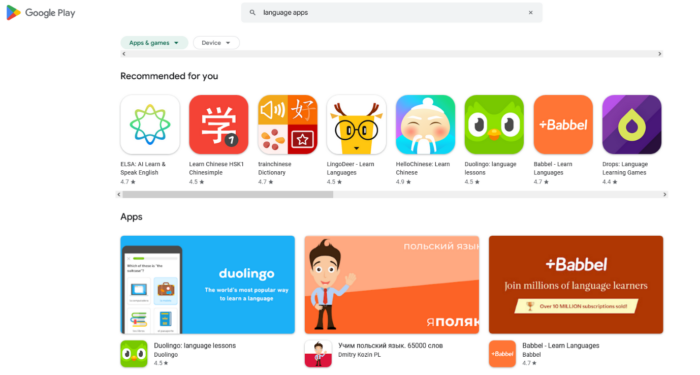Do Language Apps Really Work?
Read other articles:
Back to posts
Table of Contents

It’s sometimes said that the best way to learn a foreign language would be to have a language tutor on hand all day to help you immerse yourself in the language, correct mistakes, practice speaking and teach you vocab as needed.
Unless you’ve recently won the lottery, you’re unlikely to be able to afford to do that.
So, what’s the next best thing? Well, our smartphones follow us around all day and are always by our side. And most of us do almost everything online these days. So, surely language apps are the obvious choice to replace that 24/7 language tutor?
Or are they?
The language learning app business is already huge and steadily growing, generating $8.21 billion in 2021. You’ve probably heard of Duolingo, Mondly, Babbel, Memrise, Busuu and so on.
It’s understandable why these language learning apps have taken off in such a big way but let’s pause and ask: do they actually work?
Do they help you to speak, read or write better in the target language?
Or could your smartphone be hiding a more effective way of learning a foreign language?
Language apps hype
If you’re reading this, you likely want to do more than learn a few phrases for a holiday on the Italian Riviera.
You’re striving for bilingual status. Maybe you want to improve your employment prospects, live and work in a country that speaks your target language or you already live there and want to improve the cultural experience.
Whatever the reason, you’re aiming to speak the language at a native-speaker level or as close as possible to that.
Serious language learning takes time and effort. That’s why most people don’t get to a very high level. But it also requires the right tools and teaching methods.
It’s easy to see how apps like Duolingo are the obvious choice. They’re easy to download, accessible wherever you go, free to use (for many) and one of the most convenient ways imaginable to learn new words and phrases.

“Learn Italian in three months”, “Master Spanish in 100 days”… there are very compelling arguments to “click here” and give this or that language app a go. After all, everyone loves a shortcut.
Many big language apps like Rocket Languages or Rosetta Stone know this and are heavily marketed through affiliate programs. Popular bloggers and website owners promote their products. This can make them hard to ignore for language learners keen to use the latest and greatest learning method.
Once you start, you’re likely to get hooked quickly by the “proof of advancement” that language apps often provide. Many are also “gamified”. You might earn points or badges or some other meaningless trivia, showing you how much you’ve learnt and reeling you in further! Endless notifications and reminders urge you on.
[Warning: they can be as addictive as Candy Crush Saga].
We need to cut through the bright colors and celebration sounds as well as the marketing hype. When these apps are stripped down, how are they actually teaching languages?
Traditional language-learning methods dressed up as something new?
The tech is great – no argument. But underneath the bells and whistles, language apps use a similar method of language learning to traditional methods.
On the surface, the games and quizzes may seem engaging but still generally use inefficient ways to teach the target language and are unlikely to help you become more fluent.
Inefficient learning methods are the main reason why only a tiny fraction of the estimated 1.5 billion people learning a second language globally ever reach more than a basic proficiency level.
The traditional grammar-translation method is where students learn grammatical rules, which they apply by translating sentences between the target language and the native language. It’s derived from old teaching practices in Latin centuries ago.
With these methods, you usually learn new words and phrases with little context and little to generate interest or engagement. This means that the target language is less likely to “stick”. It’s ultimately a very inefficient way to learn.

A review paper by researchers at Columbia University and the Leuphana University of Lüneburg found that a major downfall of the majority of language apps was a rigid focus on teaching vocabulary units in “isolated chunks.”
Like with flashcards, many of the methods used may be useful in reinforcing what you already know but are unlikely to engage you enough to understand and learn the language at a more profound level.
The “skill and drill” approach can actually demotivate language learners. This is one of the major issues with many language apps and it’s why they attempt to motivate you with rewards, badges and points instead.
“Comprehensible input in a low-anxiety environment”
Linguistic expert, Stephen Krashen, proposed that language acquisition is most efficient when comprehensible input is provided in a low-anxiety environment. He goes on to say that for language learners to get the most benefit from the content, it must be compelling.
Traditional methods have rarely followed this advice. Instead, they have focused on rote learning, memorizing grammar rules and wordlists and frequent testing. This is generally uninspiring, uncompelling and stressful for the learner.
If you ever learned a second language at school, you may have been scarred for life! At my school, French lessons were little more than a convenient time to take a snooze.
Using an app puts you in more control of the learning experience than you were at school. It may also be less stressful than being forced to use language that you’re not comfortable with using (like flashcards).
But it’s also highly unlikely to sufficiently activate the senses and the learning centers of the brain to encourage taking your language learning to the next level.
A simple truth about how to become fluent
The best way to become more fluent in a foreign language is with comprehensible input – which comes mainly from listening and reading.
This goes against the grain of traditional teaching methods AND most modern language apps, where we’re taught the value of speaking.
Children listen to words and phrases in a variety of contexts (rather than in “isolated chunks” like the language apps use) and then mimic what they’ve heard when they’re ready to use it.
It sounds too simple to be true but children are the best learners and we should take good note of how they learn.
As adults, our brains are less sponge-like so we need to work a little harder. By immersing ourselves in the target language and listening and absorbing the language naturally through compelling topics and content, we can take great strides in our search for language fluency.
Start listening to and mimicking native speakers
If a language app gets you interested in learning a foreign language, great! This may improve your vocab and understanding of the grammar.
But, for language learners striving for fluency and unable to take the next step up, you’re probably going to need a lot more.
The missing link is immersion in content that engages you, encouraging you to listen and mimic the language you hear. It’s human interactions that are likely to inspire you to go the extra yard to learn a language and most language apps can’t do that.
Our simple Chrome extension does. We combine AI and human-based learning to translate material that engages you and encourages a deeper interaction with the target language.
You develop more confidence by learning in context, with visual as well as aural cues and in varied cultural situations that require different language usage. Download it here to get started and acquire language more rapidly.
Read other articles:
Back to posts
